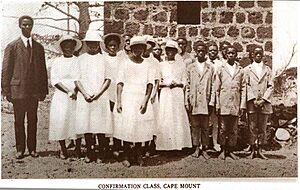Conversion to Christianity facts for kids
Becoming a Christian, or 'conversion to Christianity,' means someone who wasn't Christian before decides to follow the Christian faith. This often brings big changes in how they live, think, and act. Experts who study religion say that religious conversion was very important in how societies developed. It also helped shape the modern world we live in today.
Many people are becoming Christians, especially in places like Africa and Asia. This growth mostly happens through people converting. Throughout history, different ways of converting have been used. Sometimes, leaders tried to force people to convert. However, most Christian thinkers have always believed that conversion should be a choice.
Christian groups, called denominations, have different ways to welcome new members. The main way to join is through a special ceremony called baptism. Some denominations also have another ceremony called confirmation.
A study from 2001 found that about 2.7 million people became Christians from another religion that year. About 3.8 million people in total were converting to different faiths each year. In the early 2000s, a type of Christianity called Pentecostalism grew very fast. This growth was mostly because many people chose to convert to it.
Contents
How People Convert to Christianity
Forced Conversion in History
Christian thinkers, like Augustine in the 300s, always said that becoming a Christian must be a choice. However, there are times in history when people were forced to convert. For example, some Roman emperors used laws or force to stop other religions. They did not specifically make non-Christians convert.
Later, in the 600s, some emperors tried to make everyone Christian. They made laws saying Jewish people had to be baptized. In Spain, a king also tried to force all Jewish people to convert. In the Middle Ages, some kings in Eastern Europe pressured their people to adopt Christianity. During the Northern Crusades, leaders sometimes used political pressure or military force. Even then, many Christian thinkers still believed conversion should be voluntary.
Baptism: The Main Way to Join
In all types of Christianity, baptism is the first step to becoming part of the Christian community. During baptism, a minister usually says words like "in the name of the Father, Son, and Holy Spirit." This is done while water is used on the person.
Christians have different ideas about what baptism means. They also disagree on how it should be done. Some believe baptism is necessary for conversion. Others see it as a way to show that someone has already converted.
There are different ways to baptize people:
- Immersion: This means dipping the whole person underwater. This was common in early Christianity. It is still used by many churches today.
- Affusion: This means pouring water over the person's head. This is the most common way in many Western churches now.
- Aspersion: This means sprinkling water on the person. This was also done in ancient times, especially for sick people.
Some Christians baptize babies, which is called infant baptism. This practice was debated during the Protestant Reformation. It is still a topic of discussion for some Protestants today. However, it was done in ancient times and is not forbidden in the New Testament.
The way someone is baptized often depends on the Christian group they join. For example, many Anglicans and Lutherans baptize by pouring water. Presbyterians and Congregationalists accept pouring or sprinkling. However, many Baptists believe that only full immersion is the correct way. Other groups, like Methodists, may use all three forms of baptism.
Confirmation: A Step in Faith
Confirmation is another important step for many Christians. It was first introduced around the 400s. By the 1200s, it became a formal sacrament, which is a sacred Christian rite. Baptism, confirmation, and the Eucharist (Communion) are key parts of becoming a Christian. However, confirmation has different importance in different denominations.
Some Christians see baptism, confirmation, and communion as one unified process. Through these steps, a person becomes a Christian and a church member. In Eastern Christian churches, confirmation is called Chrismation. It is often done right after baptism, even for babies. When an adult converts to the Catholic or Orthodox Church, they first take classes. These classes teach them about the faith. After baptism, adults can be confirmed right away. A clergy member anoints them with oil, asking the Holy Spirit to bless them.
In Western churches that baptize babies, like the Catholic Church and many Protestant groups, babies are usually not confirmed right away. They wait until they are older. This allows them to make a decision for themselves. Before confirmation, young people attend classes. They must show they understand their faith and want to be confirmed. In Eastern churches, chrismation is always done right after baptism, no matter the age.
To be fully part of the Catholic Church, a convert must show their faith and take part in baptism, confirmation, and the Eucharist. The Orthodox Church also keeps baptism, chrismation, and first communion as one combined ceremony. They call chrismation "the Pentecost of the individual," referring to the Holy Spirit.
During the Reformation, some people criticized the practice of confirmation. They did not see it as a requirement for becoming a Christian. For Martin Luther, baptism was necessary, but confirmation was not. John Wesley, who started Methodism, even removed confirmation from his church for a long time. For these groups, confirmation is often seen as a prayer ceremony or a "graduation" after learning about the faith.
Images for kids
See also
- Christianization
- Forced conversion
- List of converts to Christianity
- Rite of Christian Initiation for Adults (RCIA)







